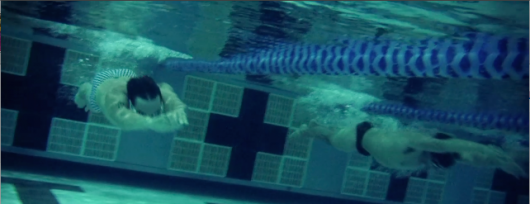Since the racing season is in full swing I hear from many athletes that they suffered from exercise-associated muscle cramping (EAMC) during the race, be it on the bike or in the swim, but first of all on the run or beyond the finish line. It became an unquestioned state-of the-art approach to relate cramps to dehydration and a salt deficit. But if you measure the electrolyte levels of these individual you will rarely find a deterioration of electrolytes. If this were the case, cramping would be a generalized phenomenon that would affect muscles that are not necessarily under strain during the respective work-out.
A brief definition of the problem
Several medical problems are encountered by Ironman triathletes. Exercise-associated muscle cramping is one of the most common medical problems encountered by the competitors in an Ironman event. Exercise-associated muscle cramping can be defined as involuntary painful skeletal muscle spasms that occur during or immediately after physical exercise. These kinds of cramps usually present as painful localized muscle cramping in different exercising muscle groups—usually the calf, ham- string or quadriceps muscles.
Exercise-associated muscle cramping should be distinguished from generalized involuntary muscle contractions in non-exercising muscles which are associated with a number of acute or chronic and congenital or acquired medical conditions.
Searching for the causes – salt and dehydration do not appear as the culprit
As already mentioned – and I am sure you are familiar with these propositions and probably even convinced that they are correct – the traditional hypotheses state that heat, dehydration and electrolyte depletion are the cause of EAMC.
But believe me the evidence supporting these traditional hypotheses is sparse. In contrast, very recent data from prospective cohort studies showed no relationship between serum electrolyte changes and dehydration respectively in the development of EAMC. Despite these findings, triathletes, coaches and scientists still need to be convinced that the development of EAMC is not necessarily related to dehydration and electrolyte depletion.
Another view on the problem of cramping – fatigue weakens control mechanisms
In 1997 Schwellnus and his co-workers offered already a hypothesis that seems much more obvious to me than the salt and dehydration narratives. They introduced a novel ‘muscle fatigue’ hypothesis for the development of EAMC which suggested that the development of ‘neuromuscular fatigue’ leads to abnormal neuromuscular control. It has been documented that fatigue increases the muscle spindle afferent activity and decreases the Golgi tendon organ afferent activity which may result in increased alpha motor neuron activity. What actually happens is that the uncontrolled firing of neurones on the muscle and the subsequently dramatically reduced relaxation phase of the muscle fibers lead to the emergence of cramps. Therefore, as muscle fatigue progresses, control mechanisms vanish and the risk for developing exercise-associated muscle cramping increases. It has been shown that there is increased baseline electromyographic activity in triathletes suffering from these cramps immediately after the race, when compared with a non-exercising control muscle. Therefore, endurance athletes who compete at a pace that is faster and harder than their usual training pace (higher relative exercise intensity), and those whose recovery has not been complete may develop muscle fatigue earlier during a race and may therefore be at a higher risk for exercise-associated muscle cramping.

Risk factors identified for developing exercise-associated muscle cramping
To find out more about the risk factors that increase susceptibility to cramping the group around Schwellnus performed a study*. 1136 triathletes (970 male (85.4%) and 166 female (14.6%)) were enrolled in the study. All of them entered an Ironman triathlon (3.8 km swim, 180 km cycle and a 42.2 km run) and were considered as potential subjects.
The main novel finding of this study was that the two independent risk factors for the development of exercise-associated muscle cramping in Ironman triathletes were a history of muscle cramping (in particular the number of exercise-associated muscle cramping reported in the last 10 races) and an overall faster race. Triathletes in the cramping group intended to perform better.
Data collected on the actual race day confirmed that both cycling and overall performance times of the cramping group of triathletes were significantly faster compared with the non- cramping group. Furthermore, there was a trend for the run times to be faster in the cramping group.
Although the study cannot directly link the faster race pace to the development of muscle fatigue, data from observational studies in animals and laboratory-based studies in humans support the hypothesis that repetitive muscle contraction results in fatigue and that this can lead to cramping, probably by altering neuromuscular control. A history of cramping was also a significant risk factor for exercise-associated muscle cramping in the cohort of triathletes. In particular, a history of cramping in the past 10 races, but not training sessions, was strongly associated with exercise-associated muscle cramping during the Ironman triathlon.
No electrolyte changes found
Another important finding from the study was that pre-race and post-race serum electrolyte (sodium and chloride) concentration changes and body weight changes did not differ between cramping and non-cramping triathletes. The hypothesis that either serum electrolyte changes, in particular serum sodium changes, or dehydration is related to exercise-associated muscle cramping, is therefore not supported by the findings of study.
The main strength of this study is that it is the largest prospective study investigating possible risk factors for exercise-associated muscle cramping in endurance athletes.
Summary
The results of the Schwellnus study confirm that there is no correlation between exercise-associated muscle cramping and changes in electrolyte concentrations or changes in hydration status. Rather, this study shows that EAMC is associated with a history of mus- cle cramping (in particular the number of EAMC reported in the last 10 races) and an overall faster race time during the Ironman triathlon. Prolonged exercise at a relatively higher intensity, compared with training, is therefore associated with the development exercise-associated muscle cramping in triathletes.
Schwellnus MP, Drew N, Collins M: Increased running speed and previous cramps rather than dehydration or serum sodium changes predict exercise-associated muscle cramping: a prospective cohort study in 210 Ironman triathletes. Br J Sports Med, 1-7, Dec. 9, 2010






This is certainly many of these a fantastic contraption who you might be rendering and also deliver it again separate for the purpose of zero cost. I just really like looking at sites who know typically the valuation from rendering some superior source of information for the purpose of zero cost. It is typically the out of date whatever approximately is available all over regular .
Well done winners but for me every person that took part in Ironman Triahtlon is really a victor
Best wishes to the many Ironman Triathlon winner and sustain every one of the individuals, it had become a great race.